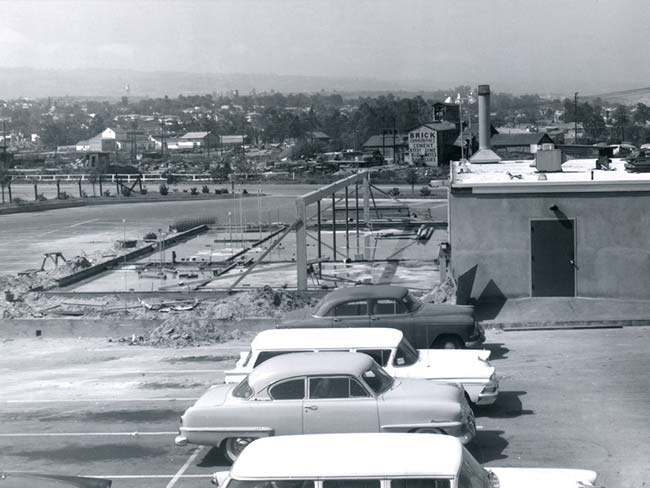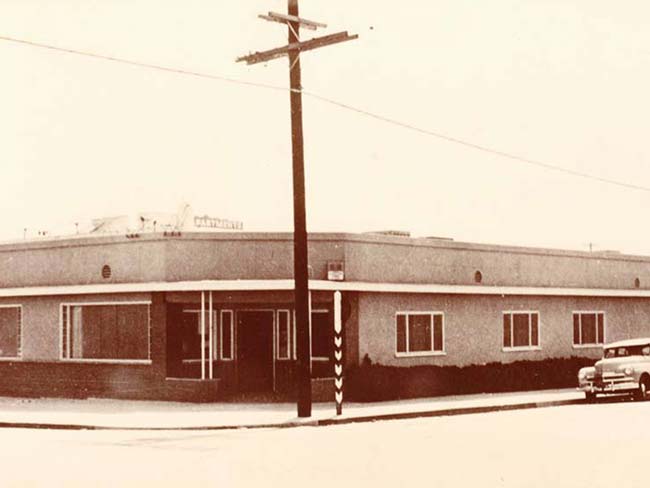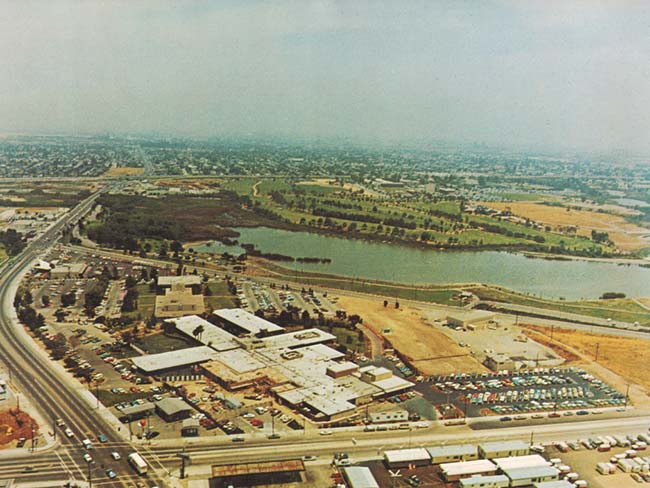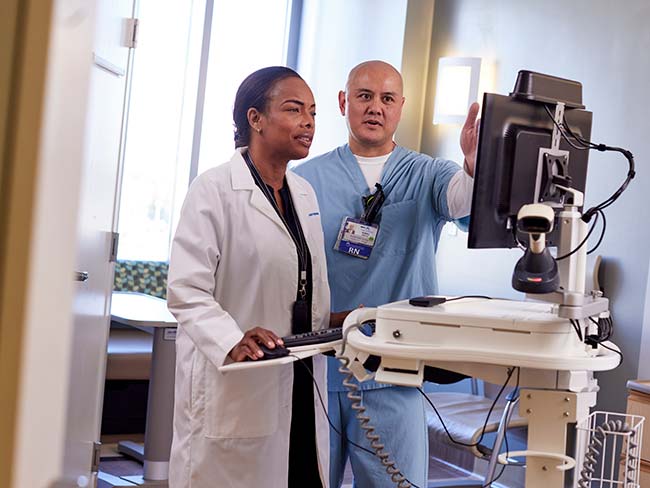Harbor City Hospital: Beachhead for labor health care
The story of Kaiser Permanente's South Bay Medical Center finds its roots in filling care gaps for union members.
Painting of proposed Harbor City hospital, circa 1955
When the Permanente Health Plan was made available to West Coast members of the International Longshore and Warehouse Union in 1950, it was a classic example of “be careful what you wish for.”
The Permanente plan, robustly serving workers and families for Henry J. Kaiser’s home front industries, expanded to the public on July 21, 1945, less than a month before the end of World War II. It was a heady and challenging period, and labor unions were to become major group members of the postwar Permanente. Why? Because, for the first time, unions could negotiate health coverage.
The key legal ruling was the 1948 decision by the Seventh Circuit United States Court of Appeals in the case of Inland Steel Company vs the National Labor Relations Board. This precedent affirmed the legal obligation of employers in unionized companies to include health and welfare benefits as part of labor negotiations.
In 1950 The International Longshoremen and Warehouse Union and the Pacific Maritime Association requested the Permanente Health Plan provide care for all 22,500 of their workers up and down the West Coast; The ILWU became the first major group enrolled in the Health Plan.
At the insistence of ILWU leader Harry Bridges, Permanente was the only choice for the union members. This exclusivity violated Permanente policy that membership should be voluntary, which understandably caused some dissatisfaction with ILWU members. It wasn’t until 1954 that ILWU members were offered a choice of a second plan after Permanente consultant and economist Avram Yedidia convinced Bridges of the importance of dual choice; only 10 percent would leave Permanente.
But there was a problem with capacity. Bridges brought in thousands of new members to a plan that was recovering from a postwar slump and had limited facilities.
For the major ports of Oakland and San Francisco, where the Permanente hospital and clinics were already established, that wasn’t a problem. Looking north, ILWU members in Seattle got care through an agreement with the Group Health Cooperative of Puget Sound and other providers while Portland-Vancouver union members were served by Northern Permanente. Southern California would involve an estimated membership of more than 11,000 longshoremen, but the only Permanente hospital was at the Fontana Steel Mill, 60 miles from the ocean. Not exactly longshore territory.
Bridges wanted a Permanente facility in the San Pedro harbor area where there was a high concentration of members. His promise convinced Permanente that this is the time and the place to expand. Enter the Harbor City Hospital, proud pioneer of the Los Angeles South Bay service area.
Temporary facilities began immediately. A history compiled for the 60 th anniversary of the South Bay area described the first San Pedro clinic:
Dr. Ray Kay (founder of the Southern California Permanente Medical Group) and Medical Director Dr. Ira “Buck” Wallin found a working clinic at 599 W. Ninth St. (and Grand Avenue) already occupied by doctors who were, at first, willing to share space. They even agreed to help take care of the longshoremen after hours. That arrangement was short-lived, however. Spooked by the economic threat posed by group practice, the doctors in the community gave the cold shoulder to Wallin’s staff and anyone who associated with them professionally or socially. The 3 fee-for-service doctors with offices in the shared clinic buckled under the pressure and vacated the premises.
Permanente promised the ILWU that they would build a new hospital in the Wilmington-San Pedro area, but progress was slow. The new Kaiser Foundation Hospital in downtown Los Angeles broke ground in late 1951, and drew institutional resources away from the Harbor City facility.
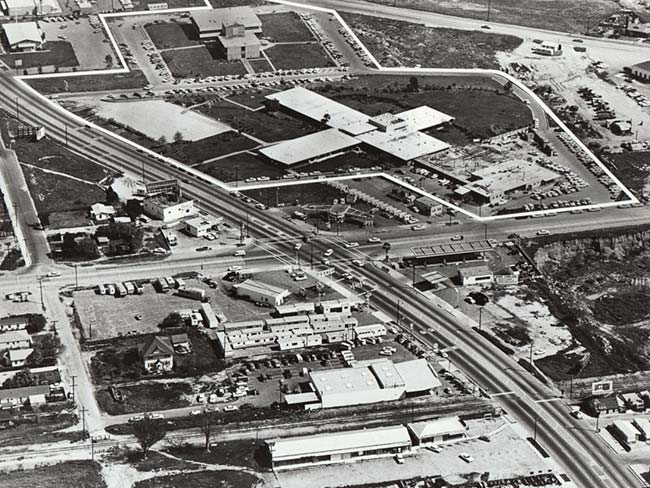
Things came to a head when 5,000 cannery workers in the San Pedro area signed up with the Permanente plan at the end of 1953. The workers’ employers had wanted them to sign up with the California Physicians’ Service, a competing prepaid plan offered through the California Medical Association. This was during the period where the medical establishment disapproved of Permanente physicians, who were barred from facilities such as San Pedro Community Hospital. The ILWU had been waiting more than 2 years for their promised hospital, and were getting cranky.
1953 was also the year the scrappy Permanente clinic in Pittsburg, Calif., opened to serve the labor unions and local community.
By early 1955 a site had been purchased, a complex deal involving 3 parcels, each held by different owners. Clarence Mayhew, the most prominent architect of Kaiser Foundation hospitals, drew up plans for a bold and innovative 66-bed hospital. It featured “vast amounts of glass,” separate corridors for staff and the public, and the famous “baby-in-a-drawer.” The groundbreaking ceremony November 4, 1955, included elected officials, leaders of the ILWU, and the PMA.
On January 14, 1957, the Kaiser Foundation Hospital in Harbor City at 1100 West Pacific Coast Highway, opened. It was hectic. At a 30-year celebration, Medical Administrator Pat Crowe reminisced “The day before we opened, carpenters were still making last-minute changes and final clean-up was not yet complete. Eighteen patients were admitted that afternoon and evening.” One of them was about to deliver her second child. At 1:54 a.m. on January 15 she gave birth to a healthy baby girl.
The ILWU Dispatcher newspaper of February 15 added this under “Local 13 Man Launches New Harbor Hospital”: First patient in the new $1,000,000 Kaiser Foundation Harbor Hospital was ILWU Local 13 member Oscar Roberts, covered through the ILWU-PMA Welfare Program.
As with all the Permanente facilities, demand always pushed capacity. Sixteen beds were added in late 1958, and a 2-story clinic at 1050 West Pacific Coast Highway was built in 1959. Additional expansion happened in 1964, bringing bed capacity up to 121. 1969 saw further clinic expansion. A serious fire destroyed a section of the adjacent Parkview Medical Office Building in 1973.
Harry Shragg, MD, served at Harbor City from 1957 until 1968 as a surgeon, chief of the Department of Surgery, administrator of a community health care program for indigents, and medical director. In his oral history, he recounted an epiphanic moment about Permanente medicine:
I was on call in the hospital one evening, and a black girl from Compton — which is a lower socio-economic level area — came into the emergency room with abdominal pain. I think she was 16 years old. And she was seen by a board-certified pediatrician, examined by a board-certified gynecologist, and examined by me, a board-certified surgeon. We took her to the operating room — she had appendicitis — and we operated on her. And the whole sequence of that one episode, to my mind, crystalized the merits, and the value, and the philosophy of this kind of practice, where the issue of whether one could afford it or not never arose… She was just a sick person who came in and needed help, and we just gave her what I thought was outstanding quality care… That was, to me, a very dramatic and very memorable occurrence, and I think that's what it's all about."
Service to working communities. Yes, that's what it's all about.
